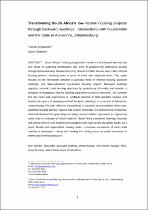 ResearchSpace
ResearchSpace
Transforming South Africa’s low-income housing projects through backyard dwellings: Intersections with households and the state in Alexandra, Johannesburg
JavaScript is disabled for your browser. Some features of this site may not work without it.
- ResearchSpace
- →
- Research Publications/Outputs
- →
- Journal Articles
- →
- View Item
| dc.contributor.author |
Shapurjee, Y

|
|
| dc.contributor.author |
Charlton, S

|
|
| dc.date.accessioned | 2014-03-11T08:17:53Z | |
| dc.date.available | 2014-03-11T08:17:53Z | |
| dc.date.issued | 2013-11 | |
| dc.identifier.citation | Shapurjee, Y and Charlton, S. 2013. Transforming South Africa’s low-income housing projects through backyard dwellings: Intersections with households and the state in Alexandra, Johannesburg. Journal of Housing and the Built Environment, vol. 28(4), pp 653-666 | en_US |
| dc.identifier.issn | 1566-4910 | |
| dc.identifier.uri | http://link.springer.com/article/10.1007%2Fs10901-013-9350-9 | |
| dc.identifier.uri | http://hdl.handle.net/10204/7280 | |
| dc.description | Copyright: 2013 Springer. This is the Pre/post print version. The definitive version is published in Journal of Housing and the Built Environment, vol. 28(4), pp 653-666 | en_US |
| dc.description.abstract | South Africa’s ‘housing programme’ transfers a fully-funded serviced site and house to qualifying beneficiaries with aims of progressively addressing poverty through homeownership. Despite delivering close to 3 million houses since 1994, informal housing persists, featuring even in some of these new neighbourhoods. This paper focuses on the intersection between a particular mode of informal housing, backyard dwellings, and state-subsidised low-income housing projects. Backyard dwellings arguably contradict state housing objectives by symbolising informality and disorder; a symptom of inadequacy that the housing programme strives to overcome. We consider first the views and experiences of landlords (owners of state-subsided houses) and tenants (occupiers of privately-provided backyard dwellings) in a section of Alexandra, Johannesburg. We then reflect on the potential of backyard accommodation within post-apartheid housing delivery, arguing that despite challenges, the phenomenon of planned, state-led infrastructure generating secondary accommodation represents an opportunity rather than an example of failed modernity. South Africa’s backyard dwellings resonate with similar forms of self-funded and managed rental stock across the global South. As a quick, flexible and regenerative housing asset, cumulative acceptance of such rental markets is necessary – along with viewing the driving actors as astute innovators in shelter and livelihood provision. | en_US |
| dc.language.iso | en | en_US |
| dc.publisher | Springer Verlag | en_US |
| dc.relation.ispartofseries | Workflow;12259 | |
| dc.subject | Alexandra | en_US |
| dc.subject | Backyard dwelling | en_US |
| dc.subject | Low-income housing | en_US |
| dc.subject | Rental housing | en_US |
| dc.subject | State infrastructure | en_US |
| dc.title | Transforming South Africa’s low-income housing projects through backyard dwellings: Intersections with households and the state in Alexandra, Johannesburg | en_US |
| dc.type | Article | en_US |
| dc.identifier.apacitation | Shapurjee, Y., & Charlton, S. (2013). Transforming South Africa’s low-income housing projects through backyard dwellings: Intersections with households and the state in Alexandra, Johannesburg. http://hdl.handle.net/10204/7280 | en_ZA |
| dc.identifier.chicagocitation | Shapurjee, Y, and S Charlton "Transforming South Africa’s low-income housing projects through backyard dwellings: Intersections with households and the state in Alexandra, Johannesburg." (2013) http://hdl.handle.net/10204/7280 | en_ZA |
| dc.identifier.vancouvercitation | Shapurjee Y, Charlton S. Transforming South Africa’s low-income housing projects through backyard dwellings: Intersections with households and the state in Alexandra, Johannesburg. 2013; http://hdl.handle.net/10204/7280. | en_ZA |
| dc.identifier.ris | TY - Article AU - Shapurjee, Y AU - Charlton, S AB - South Africa’s ‘housing programme’ transfers a fully-funded serviced site and house to qualifying beneficiaries with aims of progressively addressing poverty through homeownership. Despite delivering close to 3 million houses since 1994, informal housing persists, featuring even in some of these new neighbourhoods. This paper focuses on the intersection between a particular mode of informal housing, backyard dwellings, and state-subsidised low-income housing projects. Backyard dwellings arguably contradict state housing objectives by symbolising informality and disorder; a symptom of inadequacy that the housing programme strives to overcome. We consider first the views and experiences of landlords (owners of state-subsided houses) and tenants (occupiers of privately-provided backyard dwellings) in a section of Alexandra, Johannesburg. We then reflect on the potential of backyard accommodation within post-apartheid housing delivery, arguing that despite challenges, the phenomenon of planned, state-led infrastructure generating secondary accommodation represents an opportunity rather than an example of failed modernity. South Africa’s backyard dwellings resonate with similar forms of self-funded and managed rental stock across the global South. As a quick, flexible and regenerative housing asset, cumulative acceptance of such rental markets is necessary – along with viewing the driving actors as astute innovators in shelter and livelihood provision. DA - 2013-11 DB - ResearchSpace DP - CSIR KW - Alexandra KW - Backyard dwelling KW - Low-income housing KW - Rental housing KW - State infrastructure LK - https://researchspace.csir.co.za PY - 2013 SM - 1566-4910 T1 - Transforming South Africa’s low-income housing projects through backyard dwellings: Intersections with households and the state in Alexandra, Johannesburg TI - Transforming South Africa’s low-income housing projects through backyard dwellings: Intersections with households and the state in Alexandra, Johannesburg UR - http://hdl.handle.net/10204/7280 ER - | en_ZA |





